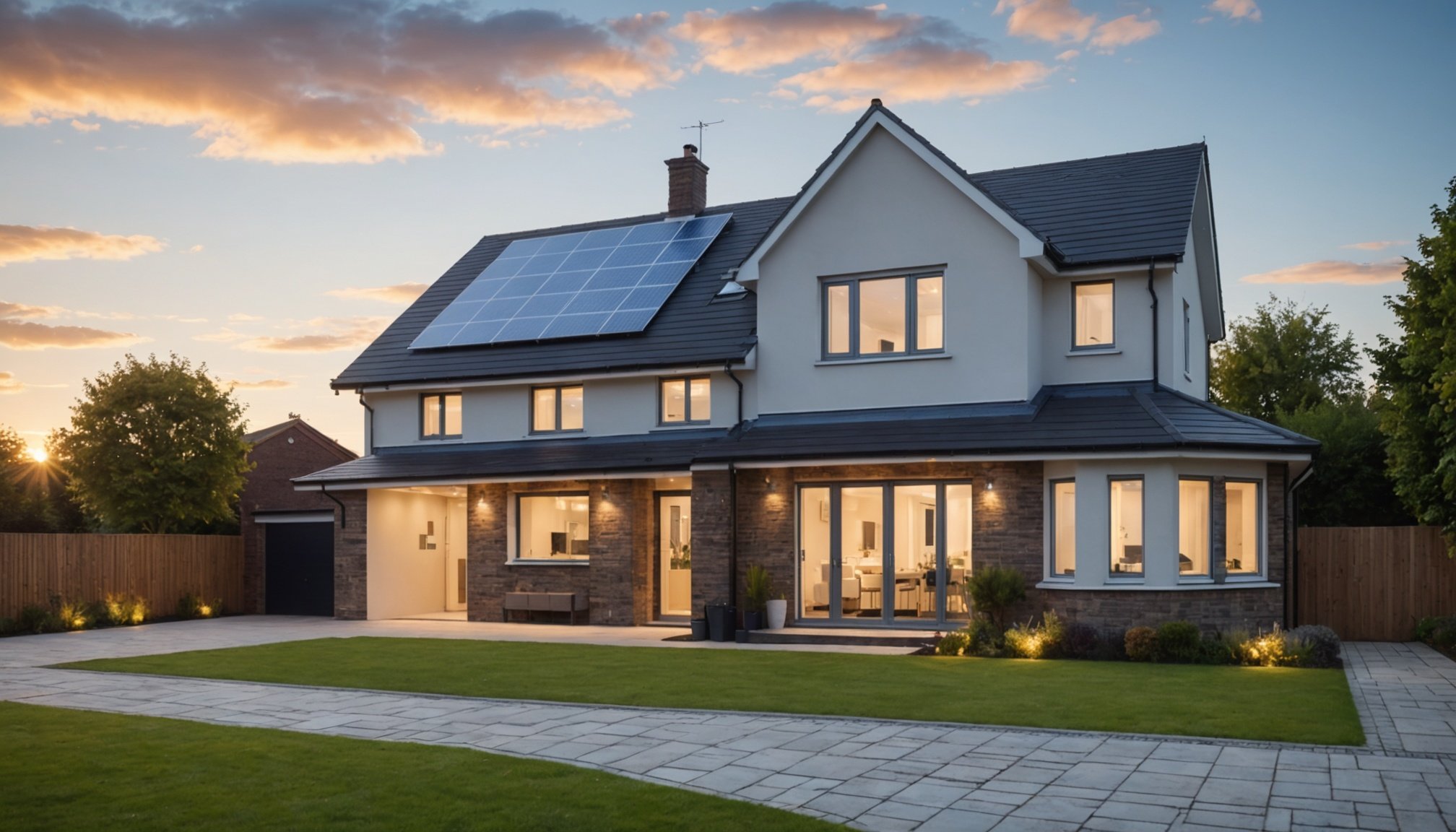Impact of AI on Energy Efficiency
Artificial Intelligence (AI) is revolutionizing how we manage energy use within our homes. Traditional home systems often rely on manual adjustments or fixed schedules, which can lead to energy waste. In contrast, AI-enhanced systems continuously learn and adapt to your habits, optimizing energy consumption automatically.
An essential example of this transformation is the use of smart thermostats. These devices intelligently adjust temperatures based on real-time data, significantly reducing unnecessary heating or cooling. They learn from your daily routines and even sync with weather forecasts to maximize efficiency. This automated system means less intervention from homeowners, contributing to substantial energy reduction over time.
This might interest you : Unveiling the leading ai innovations transforming content creation in the uk media scene
Aside from temperature control, AI also enhances lighting systems. Automated lighting adjusts based on occupancy and natural light levels, ensuring lights are used only when needed. This not only saves energy but also extends the lifespan of bulbs, decreasing replacement costs.
The comparison between traditional and AI-enhanced systems further highlights the efficiency gains. While conventional systems require constant user input, AI systems anticipate needs and implement solutions proactively, ensuring a more energy-efficient home environment—a shift that is paramount in today’s energy-conscious world.
Topic to read : Unveiling groundbreaking ai innovations revolutionizing public safety across the uk
Overview of AI-Powered Smart Homes
The concept of AI-powered smart homes has rapidly evolved, transforming domestic life with advanced AI technology. These homes utilise smart home systems that are designed to optimise daily living, enhance energy efficiency, and improve convenience. At the core, AI technology in smart homes aggregates data from various connected devices, processes it, and performs automated actions to improve household management without manual intervention.
AI technology in these systems ensures intelligent automation. Smart devices can adjust lighting, heating, and even appliance usage based on learned behaviour patterns and external environmental data. This allows for seamless energy management, reducing excess usage and therefore enhancing energy efficiency. The systems learn and adapt, providing a tailored experience that ensures maximum comfort with minimal energy waste.
In the UK, there is a notable trend towards adopting smart home systems. Homes across the nation are increasingly integrating this technology, driven by incentives for sustainability and energy conservation. As more households recognise the benefits, such as reduced energy bills and increased comfort, the adoption rate of smart home technology continues to climb. The government and private sectors are also pushing for innovations, ensuring that the UK becomes a leader in energy-efficient smart home systems.
Case Studies and Statistics from the UK
AI-powered smart home systems are not just a futuristic concept but are actively transforming households across the UK. Real-world success stories highlight their tangible benefits. For instance, a significant portion of users report up to 30% energy reduction after implementing smart thermostats and AI-managed lighting systems. These technologies inherently adjust to real-time data, optimizing energy use and enhancing energy efficiency.
Several UK innovations in the smart home sector continue to pave the way for broader acceptance. The integration of AI technology into housing complexes by local councils has proven to drastically cut operational costs. A recent case in Birmingham showed a 25% monthly saving on energy bills, proving the practical financial impacts of AI technology in urban settings.
Data analysis from these implementations presents compelling evidence: households using AI-enhanced systems consistently see reduced energy expenditure. Testimonials from users don’t just focus on savings, but also improvements in convenience and comfort. One resident shared, “Adjustments to temperature and lighting are so seamless—I don’t even think about energy use anymore.” This highlights the dual focus of cost reduction and improved quality of life, validating the transformative nature of these technologies.
Potential Savings with AI-Powered Smart Homes
The financial allure of AI-powered smart homes is a compelling motivator for many. Cost reduction on energy bills is among the most pronounced benefits. By leveraging smart devices such as thermostats and automated lighting systems, households cut unwarranted energy consumption—translating into genuine financial savings. These devices fine-tune their operation based on AI technology, learning from daily routines and environmental factors.
Breakdown of Potential Cost Savings
-
Energy-efficient devices: Smart thermostats can lead to as much as a 30% reduction in heating and cooling costs.
-
Automated systems: AI-managed lighting optimises electricity usage, providing notable savings on monthly bills.
Long-term Financial Benefits
Investing in smart home systems offers not just immediate savings, but valuable long-term financial benefits. Homeowners see a significant reduction in energy-related expenses over time, which compensates the initial investment in technology.
The return on investment (ROI) for smart home technology is favourable, as it merges convenience with efficiency, delivering sustained savings. In fact, many users report a return on their investment within a couple of years.
As technology advances, the cost-saving potential of AI technology in smart homes will only grow, steadily increasing overall energy efficiency.
Guidance on Implementing AI Technologies
Adopting AI technologies to transform your home into a smart home can seem overwhelming. However, with the right adoption strategies and practical tips, this process becomes manageable and rewarding. Understanding what smart devices fit your needs is critical. Smart thermostats, automated lighting, and AI-powered assistants are popular choices due to their efficiency in managing energy use.
Selecting the Right Smart Devices
Begin by evaluating your lifestyle and specific requirements. Smart thermostats suit those focused on heating and cooling efficiency, while automated lighting is ideal for optimising light use. Choose devices that integrate with existing systems for seamless operation.
Integrating AI into Existing Systems
Incorporate AI tools with a structured approach. Start with easily adaptable devices that don’t demand substantial changes to your current setup. Consider compatibility and ensure that new devices can communicate with each other for optimal performance.
Ensuring Compatibility and Scalability
When investing in smart technology, future-proofing is essential. Opt for devices that allow scalability, so your smart home can expand with technological advancements. This not only ensures longevity but also prepares your home for future innovations in smart living. By thoughtfully implementing AI technologies, you enjoy enhanced energy management and a modernised living experience.
Future of Smart Homes in the UK
The integration of AI in smart homes is set to transform domestic life, with emerging technologies poised to drive significant advancements. One such innovation is the development of machine learning algorithms that seamlessly automate household functions. This technology learns from user behaviour, progressively enhancing automation efficiency—leading to better energy management and increased convenience.
Emerging smart home technologies are anticipated to rise with the UK’s focus on sustainability. These technologies include advanced energy management platforms that leverage AI to optimize energy use more precisely than ever before. Moreover, sustainability remains a core advantage as AI systems ensure energy resources are utilized efficiently, aligning with national energy policies.
Market predictions indicate a substantial growth in consumer adoption. More homeowners are expected to invest in AI-enabled devices, underpinned by incentives for smart home implementation and a heightened awareness of their benefits. This growth trajectory is not only expected to be dynamic but also widespread.
These market trends are vital in shaping the future landscape of UK housing. With AI technology progressively evolving, it holds the potential to make homes more self-sufficient, reduce carbon footprints, and support the nation’s sustainability goals effectively. This continuous development ensures the future of smart homes is both exciting and promising.











